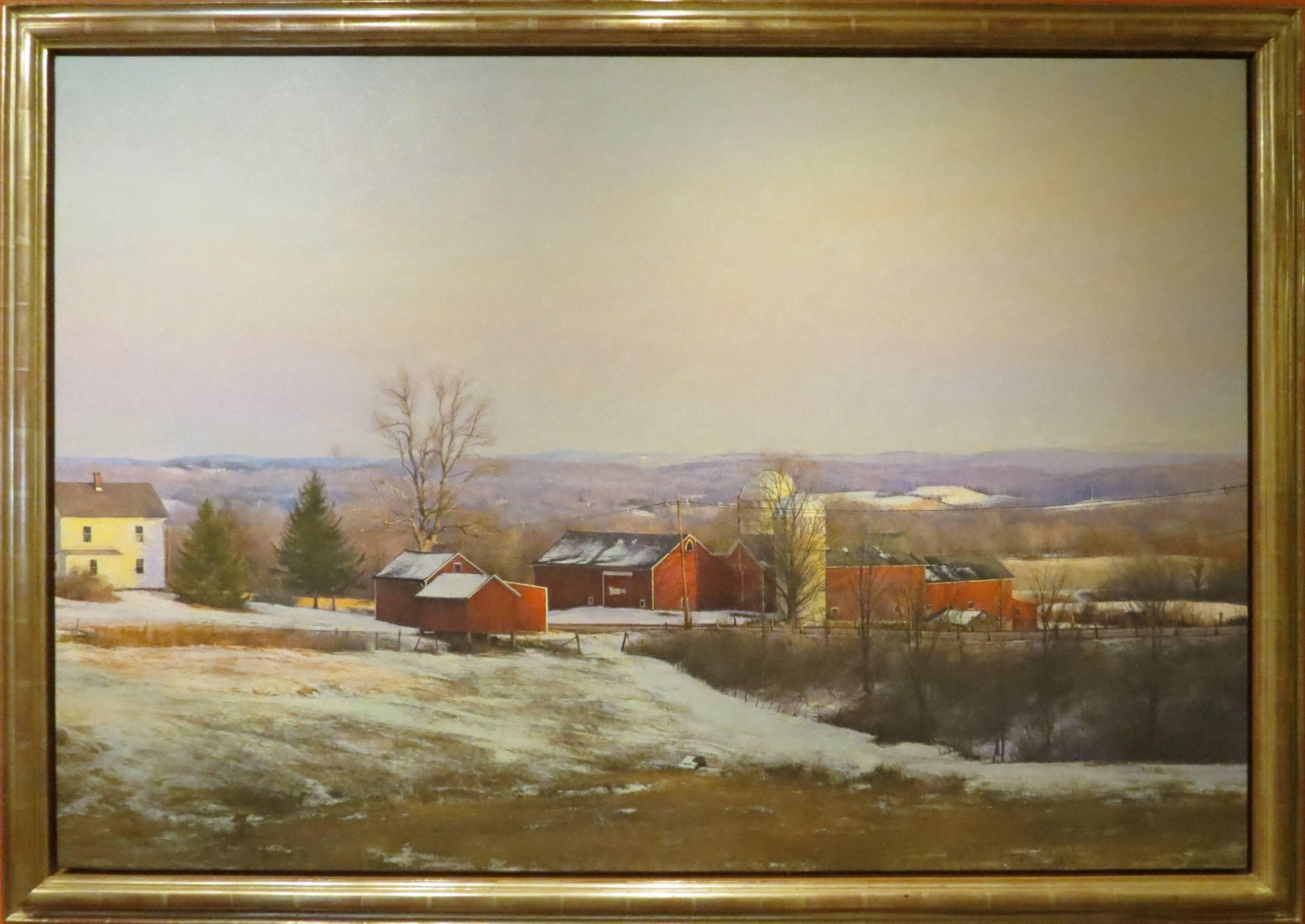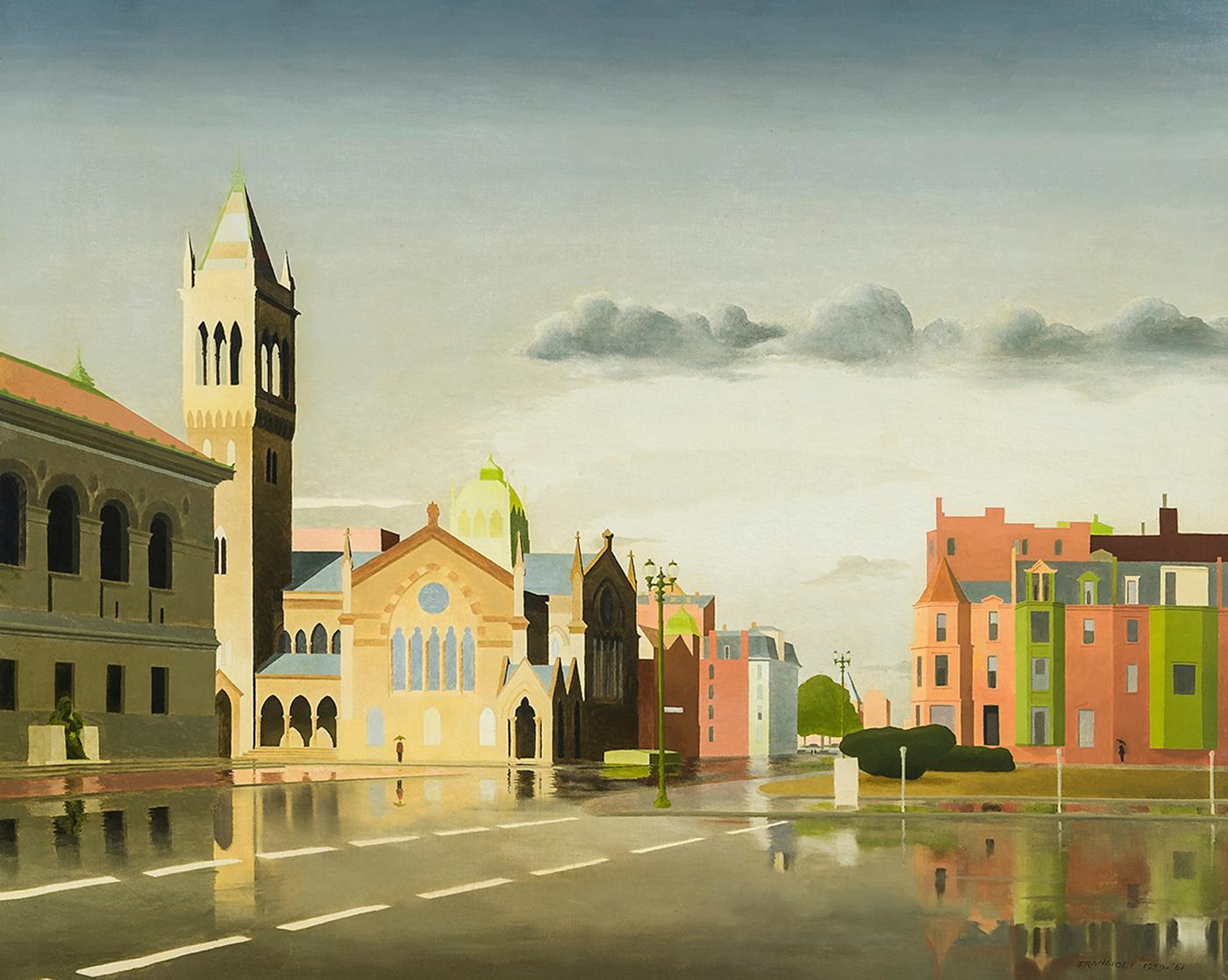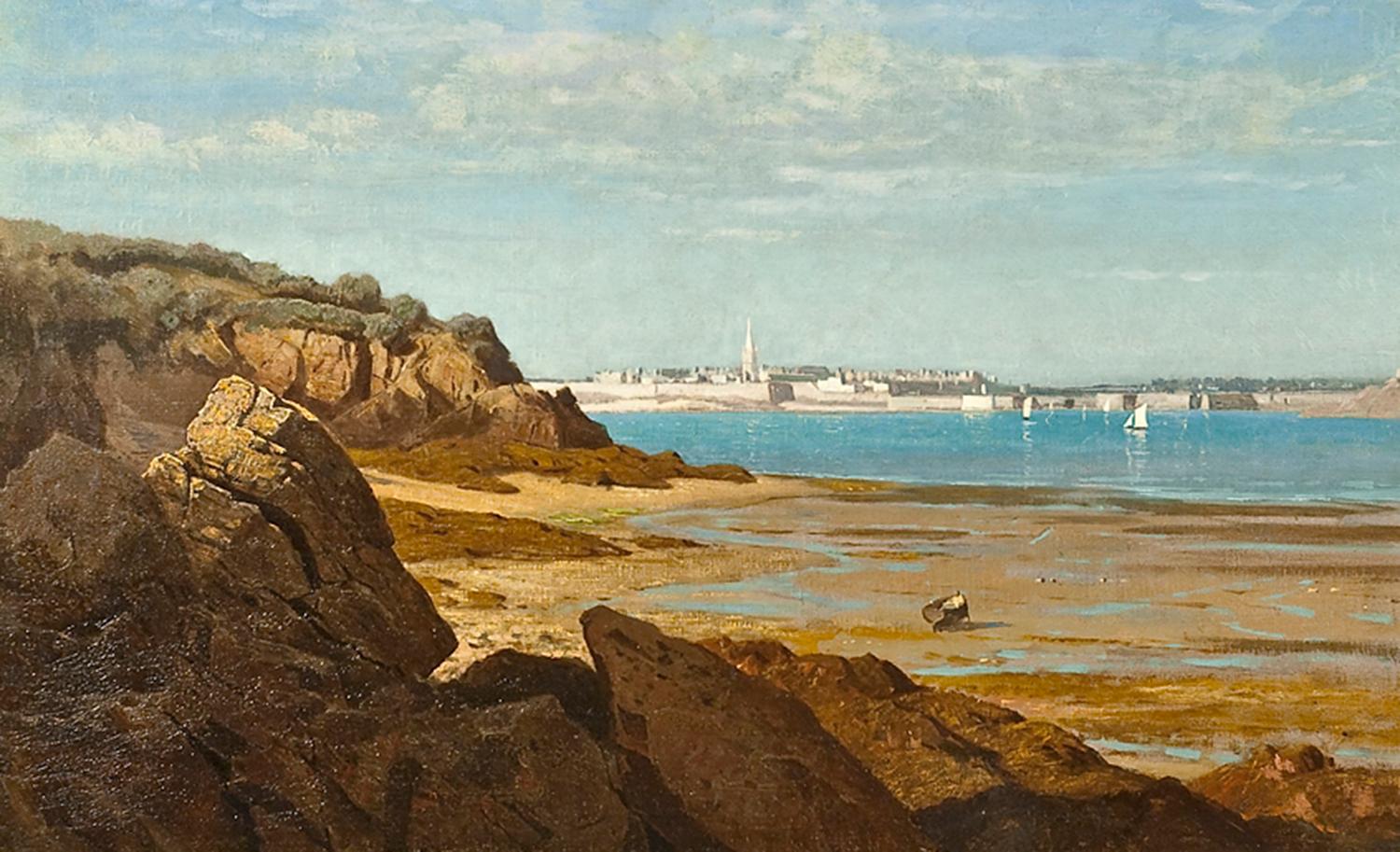Items Similar to Cerro Castellan, A.M.
Want more images or videos?
Request additional images or videos from the seller
1 of 5
Bob Stuth-WadeCerro Castellan, A.M.2022
2022
About the Item
This painting is oil on aluminum panel. It is not framed.
Eleanor Jones Harvey, Chief Curator at the Smithsonian American Art Museum, writes about Bob Stuth-Wade:
“Over the course of his career, Bob Stuth-Wade has examined his responses to life through landscape, still life, portraiture, and abstraction. Restlessly creative, he has explored these varied genres with equal concentration…..”
Bob Stuth-Wade’s method of painting is uniquely his own, having taught himself technique; his only formal training was as a teenager with Dallas artist Perry Nichols. His process often entails the creation of an initial ‘energy’ study in artist-made charcoal, several works on paper, and a large detailed painting of the same subject. Each step in the process enriches his understanding of his subject.
Since his first solo exhibition in 1971, at age 18, Bob Stuth-Wade has been a full-time artist. In addition to ten solo exhibitions at Valley House Gallery since 1991, his work has been exhibited at The Grace Museum in Abilene, Texas, and the San Angelo Museum of Fine Arts in San Angelo, Texas. His work is in numerous public and private collections.
- Creator:Bob Stuth-Wade (1953, American)
- Creation Year:2022
- Dimensions:Height: 11 in (27.94 cm)Width: 14 in (35.56 cm)
- Medium:
- Movement & Style:
- Period:
- Condition:
- Gallery Location:Dallas, TX
- Reference Number:
About the Seller
5.0
Recognized Seller
These prestigious sellers are industry leaders and represent the highest echelon for item quality and design.
Established in 1954
1stDibs seller since 2013
151 sales on 1stDibs
Typical response time: Several days
Associations
Art Dealers Association of America
- ShippingRetrieving quote...Ships From: Dallas, TX
- Return PolicyA return for this item may be initiated within 2 days of delivery.
More From This SellerView All
- Sam Bass Canyon, Set RanchBy Bob Stuth-WadeLocated in Dallas, TXThe overall dimensions, including the blond wood float frame, are 21 3/8 x 17 5/16 inches. The painting is oil on canvaspanel. Eleanor Jones Harvey, Chief Curator at the Smithsonian American Art Museum, writes about Bob Stuth-Wade: “Over the course of his career, Bob Stuth-Wade has examined his responses to life through landscape, still life, portraiture, and abstraction. Restlessly creative, he has explored these varied genres with equal concentration…..” Bob Stuth-Wade’s method of painting is uniquely his own, having taught himself technique; his only formal training was as a teenager with Dallas artist Perry...Category
2010s American Realist Landscape Paintings
MaterialsOil, Canvas, Panel
- Mount HardcaseBy Bob Stuth-WadeLocated in Dallas, TXThe overall dimensions including the frame are 32 1/2 x 23 5/8 inches. Eleanor Jones Harvey, Chief Curator at the Smithsonian American Art Museum, writes about Bob Stuth-Wade: “Over the course of his career, Bob Stuth-Wade has examined his responses to life through landscape, still life, portraiture, and abstraction. Restlessly creative, he has explored these varied genres with equal concentration…..” Bob Stuth-Wade’s method of painting is uniquely his own, having taught himself technique; his only formal training was as a teenager with Dallas artist Perry...Category
2010s American Realist Landscape Paintings
MaterialsOil, Canvas, Panel
- Mill Before BurningBy Bob Stuth-WadeLocated in Dallas, TXEleanor Jones Harvey, Chief Curator at the Smithsonian American Art Museum, writes about Bob Stuth-Wade: “Over the course of his career, Bob Stuth-Wade has examined his responses to...Category
2010s American Realist Paintings
MaterialsPanel, Oil
- Empty AfternoonBy Bob Stuth-WadeLocated in Dallas, TXEleanor Jones Harvey, Chief Curator at the Smithsonian American Art Museum, writes about Bob Stuth-Wade: “Over the course of his career, Bob Stuth-Wade has examined his responses to...Category
21st Century and Contemporary American Realist Paintings
MaterialsPanel, Oil
- Cerro Castellan, Narrow ViewBy Bob Stuth-WadeLocated in Dallas, TXThis painting is oil on gessobord panel. The overall dimensions including the frame are 17 x 14 inches. Eleanor Jones Harvey, Chief Curator at the Smithsonian American Art Museum, writes about Bob Stuth-Wade: “Over the course of his career, Bob Stuth-Wade has examined his responses to life through landscape, still life, portraiture, and abstraction. Restlessly creative, he has explored these varied genres with equal concentration…..” Bob Stuth-Wade’s method of painting is uniquely his own, having taught himself technique; his only formal training was as a teenager with Dallas artist Perry...Category
21st Century and Contemporary American Realist Landscape Paintings
MaterialsPanel, Oil
- Cerro Castellan from CostolonBy Bob Stuth-WadeLocated in Dallas, TXThe overall dimensions including the frame are 13 3/8 x 17 3/8 inches. Eleanor Jones Harvey, Chief Curator at the Smithsonian American Art Museum, writes about Bob Stuth-Wade: “Over the course of his career, Bob Stuth-Wade has examined his responses to life through landscape, still life, portraiture, and abstraction. Restlessly creative, he has explored these varied genres with equal concentration…..” Bob Stuth-Wade’s method of painting is uniquely his own, having taught himself technique; his only formal training was as a teenager with Dallas artist Perry...Category
21st Century and Contemporary American Realist Landscape Paintings
MaterialsPanel, Oil
You May Also Like
- "Snow Squals, Parmelee Farm"By Peter PoskasLocated in Lambertville, NJSigned Lower Left Poskas was born in Waterbury, Connecticut, a small industrial city set on the banks of the Naugatuck River. He was interested in art as a child, but on entering ...Category
20th Century American Realist Landscape Paintings
MaterialsCanvas, Oil
- Strawberries Strewn on a Forest FloorBy William Mason BrownLocated in New York, NYWilliam Mason Brown was born in Troy, New York, where he studied for several years with local artists, including the leading portraitist there, Abel Buel Moore. In 1850, he moved to ...Category
19th Century American Realist Landscape Paintings
MaterialsCanvas, Oil
- Figure in a LandscapeBy David JohnsonLocated in New York, NYSigned (at lower right): DJ [monogram]; (on back): David Johnson 1865Category
Mid-19th Century American Realist Landscape Paintings
MaterialsOil, Board
- Copley Square, BostonBy Thomas FransioliLocated in New York, NYThomas Fransioli’s cityscapes are crisp and tidy. Buildings stand in bold outline, trees are sharp, and saturated color permeates the scene. But Fransioli’s cities often lack one critical feature: people. His streets are largely deserted, save for the rare appearance of figure and the occasional black cat scurrying across pavement. Instead, humanity is implied. Magic Realism neatly characterizes Fransioli’s viewpoint. First applied to American art in the 1943 MoMA exhibition “American Realists and Magic Realists...Category
20th Century American Realist Landscape Paintings
MaterialsCanvas, Oil
- New York from HobokenBy William Rickarby MillerLocated in New York, NYSigned (at lower left): W.R. Miller/ 1851Category
Mid-19th Century American Realist Landscape Paintings
MaterialsCanvas, Oil
- Saint-Malo, BrittanyBy William Stanley HaseltineLocated in New York, NYThe career of William Stanley Haseltine spans the entire second half of the nineteenth century. During these years he witnessed the growth and decline of American landscape painting, the new concept of plein-air painting practiced by the Barbizon artists, and the revolutionary techniques of the French Impressionists, all of which had profound effects on the development of painting in the western world. Haseltine remained open to these new developments, selecting aspects of each and assimilating them into his work. What remained constant was his love of nature and his skill at rendering exactly what he saw. His views, at once precise and poetic, are, in effect, portraits of the many places he visited and the landscapes he loved. Haseltine was born in Philadelphia, the son of a prosperous businessman. In 1850, at the age of fifteen, he began his art studies with Paul Weber, a German artist who had settled in Philadelphia two years earlier. From Weber, Haseltine learned about Romanticism and the meticulous draftsmanship that characterized the German School. At the same time, Haseltine enrolled at the University of Pennsylvania, and took sketching trips around the Pennsylvania countryside, exploring areas along the Delaware and Susquehanna rivers. Following his sophomore year, Haseltine transferred to Harvard University. After graduating from Harvard in 1854, Haseltine returned to Philadelphia and resumed his studies with Weber. Although Weber encouraged Haseltine to continue his training in Europe, the elder Haseltine was reluctant to encourage his son to pursue a career as an artist. During the next year, Haseltine took various sketching trips along the Hudson River and produced a number of pictures, some of which were exhibited at the Pennsylvania Academy of the Fine Arts in the spring of 1855. Ultimately, having convinced his father that he should be allowed to study in Europe, Haseltine accompanied Weber to Düsseldorf. The Düsseldorf Academy was, during the 1850s, at the peak of its popularity among American artists. The Academy’s strict course of study emphasized the importance of accurate draftsmanship and a strong sense of professionalism. Landscape painting was the dominant department at the Düsseldorf Academy during this period, and the most famous landscape painter there was Andreas Achenbach, under whom Haseltine studied. Achenbach’s realistic style stressed close observation of form and detail, and reinforced much of what Haseltine had already learned. His Düsseldorf training remained an important influence on him for the rest of his life. At Düsseldorf, Haseltine became friendly with other American artists studying there, especially Emanuel Leutze, Worthington Whittredge, and Albert Bierstadt. They were constant companions, and in the spring and summer months took sketching trips together. In the summer of 1856 the group took a tour of the Rhine, Ahr, and Nahe valleys, continuing through the Swiss alps and over the Saint Gotthard Pass into northern Italy. The following summer Haseltine, Whittredge, and the painter John Irving returned to Switzerland and Italy, and this time continued on to Rome. Rome was a fertile ground for artists at mid-century. When Haseltine arrived in the fall of 1857, the American sculptors Harriet Hosmer, Chauncey B. Ives, Joseph Mozier, William Henry Rinehart...Category
19th Century American Realist Landscape Paintings
MaterialsCanvas, Oil





